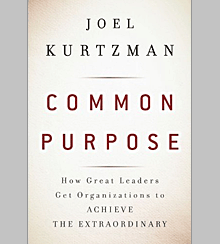The Uncommon Practice of Common Purpose
James H. Gilmore, coauthor of Authenticity: What Consumers Really Want, introduces a tale of learning from unusual places found in Common Purpose: How Great Leaders Get Organizations to Achieve the Extraordinary, by Joel Kurtzman.
For nearly 30 years, managers have known the value of providing service excellence and having the tools to analyze and improve service. Yet in most encounters consumers have with businesses, service is not extraordinary. In fact, it often stinks. Why?
One prime reason is that too many executives don’t tap enough uncommon sources to inspire a common purpose within their enterprises. They look for best practices instead of best principles. They focus exclusively on ROI (return on investment) and instead get RODNN (return on doing nothing new, pronounced “rotten”).
The world needs more authentic experiences. Consumers crave them. What is telling about the story you are about to read from Joel Kurtzman’s new book, Common Purpose, is how the staging of distinctive experiences for customers begins with the staging of unique experiences for employees. It’s a lesson and a practice any true leader should readily embrace.
— James H. Gilmore
Excerpted from Chapter 10 of Common Purpose: How Great Leaders Get Organizations to Achieve the Extraordinary
One of my favorite cities is Kyoto, Japan, a remarkable city with wonderful architecture, cherry trees galore, and fascinating Zen gardens. On one trip, my hosts, a group of Japanese automobile executives, took me to [an] Italian restaurant. I was perplexed. Here we were in the center of old Japan, with traditional restaurants, tea shops, and ryokans (traditional Japanese hotels), and my hosts wanted to eat Italian food? Did they think I was so unrefined and provincial that I had no appreciation of Japanese cuisine?
Actually the reason they wanted to take me to this restaurant was to show me something they thought was important about leadership. The restaurant, which looked like a traditional Japanese restaurant on the outside, was very Italian on the inside, with warm pastel colors, white tablecloths, candles, and Western flatware rather than chopsticks.
I remember having a pasta dish and a veal entrée. The sauces were delicate and very much like what I had eaten in northern Italy. The pairing of wines was impeccable. And the selection of Italian wines was vast. It was a wonderful dining experience. But why an Italian restaurant? I asked my hosts.
“We wanted to show you something special,” one of my hosts said.… “We think it provides a good lesson about leadership.”
“Which is?” I asked, leaning in and savoring the last drops of wine.
“Once a year, the owner of this restaurant closes his doors for ten days and takes all of his employees on a trip to Italy. They go to a different region each year. The waiters go, the chefs go, even the dishwashers go. As they travel the country, they of course pay attention to the food. But they also pay attention to the ambiance, to the way the plates are prepared, to the service, and to the way each different food is served. They go to Italy for the experience, and when they return, they recreate that experience in this restaurant.”
“Isn’t that quite expensive?” I asked.
“Yes,” my host replied. “But when the owner and the restaurant staff return, everyone in town is excited about what they learned and about the new dishes they will soon be serving. Business always picks up,” he noted.
In addition, these visits to Italy rebuild the restaurant’s esprit de corps. Everyone who works there feels special — as if they are on a mission on behalf of their clients to discover what will delight them.
The restaurant’s owner is not a wealthy man. Closing his doors for almost two weeks comes at a price. But he decided when he opened his restaurant that he wanted it to be the best and most authentic Italian restaurant in Kyoto — perhaps in all of Japan. He wanted his restaurant to be authentic not just with regard to cuisine, but also with regard to the experience he provided to his guests. As a leader, it was explained to me, the owner did not really care that his restaurant cost more to run than other restaurants that got their recipes from books. He knew that by making a regular pilgrimage to Italy, he was creating a mystique for his endeavor and that customers would pay more for the experience of tasting something novel and good.
But the real surprise was that an executive at a global, multibillion-dollar Japanese automaker would care about a business as small as a restaurant with only one branch as an example of how people should lead.
— Joel Kurtzman
Excerpted with permission of the publisher, Jossey-Bass, a Wiley imprint, Common Purpose: How Great Leaders Get Organizations to Achieve the Extraordinary. Copyright © 2010 by Joel Kurtzman.





